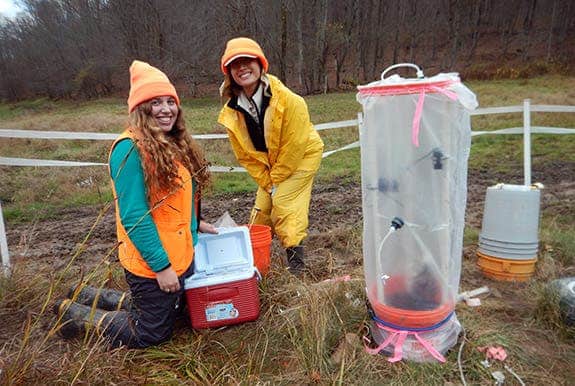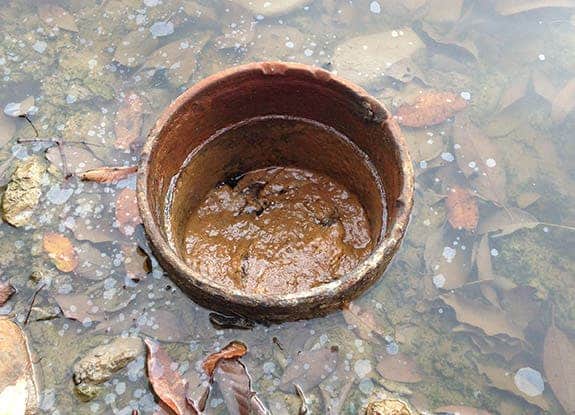Princeton University researchers have uncovered a previously unknown and potentially substantial source of methane emissions: abandoned oil and gas wells. After analyzing wells from Pennsylvania, they found that a worrying amount of them leaked significant quantities of the greenhouse gas.

Alana Miller (left), a Princeton senior majoring in civil and environmental engineering, and Mary Kang, then a doctoral researcher in civil and environmental engineering at Princeton, conduct research that found abandoned oil and gas wells emit methane, a powerful greenhouse gas. (Photo courtesy of Robert Jackson, Stanford University)
A previous Stanford study estimated about 3 million abandoned wells in the United States alone, so if these wells are indeed leaking big quantities of methane, then there’s serious reason to worry about this. For this study Princeton researchers chose very diverse wells,from fields in Pennsylvania but these measurements need to also be taken in other states with a long history of oil and gas development such as California and Texas.
“The research indicates that this is a source of methane that should not be ignored,” said Michael Celia, the Theodore Shelton Pitney Professor of Environmental Studies and professor of civil and environmental engineering at Princeton. “We need to determine how significant it is on a wider basis.”
Pound for pound, methane (CH4) is 20 times more potent as a greenhouse gas than carbon dioxide, but it is emitted in much lower quantities; still, it’s considered to be the second most important contributor to the greenhouse effect. Methane is produced naturally through decomposition but also by humans, most notably through the oil and gas industry. While oil and gas companies have worked to reduce emissions for their newer wells, very little attention has been paid to older wells and in most parts of the world (US included), they have been virtually ignored. Many wells that date back to the 19th century and early 20th century are abandoned and not recorded anywhere officially.
Mary Kang, a former doctoral candidate in civil and environmental engineering at Princeton was studying carbon sequestration through burial. She found that quite often, the carbon manages to escape underground storage, and this led her to wonder if something similar is happening with old wells. But she first ran into a big problem.
“I was looking for data, but it didn’t exist,” said Kang, now a postdoctoral researcher at Stanford.
In a new paper, Mary worked with colleagues to get new data and fill in the gaps. Initially, she focused on 19 wells in Pennsylvania. While all the wells had some level of methane emission, about 15 percent emitted much more than the others – over a thousand times more. Denise Mauzerall, a Princeton professor and a member of the research team said it was critical to understand what makes these wells different from the others.

A well pipe emerges from the ground in the Allegheny National Forest in northwestern Pennsylvania. Researchers covered pipes from 19 wells with instruments to measuring gases emitted by the well. (Photo courtesy of Mary Kang, Department of Civil and Environmental Engineering)
This makes a lot of sense, because unfortunately, putting a plug on every single abandoned well is not realilstic. But putting a plug on these high emitters is much more doable.
“The fact that most of the methane is coming out of a small number of wells should make it easier to address if we can identify the high-emitting wells,” said Mauzerall, who has a joint appointment as a professor of civil and environmental engineering and as a professor of public and international affairs at the Woodrow Wilson School.
Judging by their sample size, they extrapolated the results to see how much of the total human-emitted greenhouse gases come from abandoned wells. The result was shocking: 10%. Of course, the sample size is very small and the results are still preliminary, but the figure is shocking – it’s as big as current oil and gas production; and unlike active oil and gas wells, which will emit for 10-15-20 years, abandoned wells will emit for centuries to come.
“This may be a significant source,” Mauzerall said. “There is no single silver bullet but if it turns out that we can cap or capture the methane coming off these really big emitters, that would make a substantial difference.”
Journal Reference: Mary Kanga, Cynthia M. Kannoa, Matthew C. Reida, Xin Zhangb, Denise L. Mauzeralla, Michael A. Celiaa, Yuheng Chenc and Tullis C. Onstottc. Direct measurements of methane emissions from abandoned oil and gas wells in Pennsylvania.









